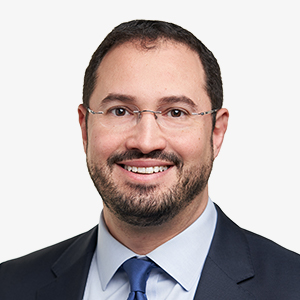We believe the supply of secondary transactions initiated by GPs has been outstripping the capital available for such transactions, and that was before the current scramble for liquidity across the asset class. We believe that’s good news for savvy secondary investors.
Introduction
Many private equity (PE) investors entered 2022 with a numerator challenge: Their private investments performed better, and were drawn down faster, than anticipated. Then came the denominator effect, wrought by a confluence of economic headwinds that roiled public markets and barred the exit doors, leaving many investors overallocated to PE. Now, as traditional PE exits have shut, the asset class has started to draw down more capital than it is returning, further exacerbating a challenging situation for many investors.
Against this backdrop, the secondary market is one of the few options for liquidity which is in greater demand than at any other time in recent years. However, capital formation in the secondary markets generally hasn’t kept pace with deal supply, thereby creating an attractive supply and demand imbalance that we believe will persist for a period of time.
In this paper, we will briefly explore the rise of GP-led secondaries; why we believe they offer increasingly attractive opportunities for seasoned PE investors in a stubbornly volatile climate; and finally, what we think it would take to ultimately succeed in this market.
GP-Leds Take Center Stage
Today, GP-led secondaries are one of the fastest-growing alternative asset classes. GP-led transaction volumes have roughly quintupled over the last five years as primary PE fund managers seek to hold onto portfolio companies to continue creating value while offering greater liquidity to their limited partners (see below).
GP-Led Secondary Transaction Volume ($ In Billions)

Source: Jefferies Global Secondary Market Review. Data as of October 2022. NB analysis as of October 2022.
So-called “continuation funds” account for a vast majority (about 80%) of GP-led transactions. In this structure, a GP decides to sell one or more portfolio companies from a typical, 10-year primary fund to a new investment vehicle—the continuation fund—managed by the same GP and set up in negotiation with secondary investors. We believe that GPs are increasingly turning to the secondary market to structure continuation funds because of several important benefits relative to traditional exit options:
- LPs in the primary fund can either cash out their current stakes or roll them into the new fund to extract additional value from select, high-conviction assets, allowing the individual LP to manage its specific duration and cash flow objectives.
- GPs get extra time and capital to create more value in some of their most successful portfolio companies. Historically, the best performers were often sold to competing PE firms, often generating strong results for the acquiring sponsor. Today, rather than choosing to sell their best holdings, GPs are increasingly partnering with investors in the secondary market to create liquidity options for their LPs while maintaining ownership and control of these select companies.
A Buyer-Friendly Market
Despite the momentous growth in GP-led transactions, we believe this market has plenty of additional runway as more GPs and LPs desire alternative liquidity solutions. (For more context, see: The Historical Impact of Economic Downturns on Private Equity and Secondaries Market Quality Post-COVID.)
We also believe current market conditions will likely accelerate this long-term growth trend and create even more attractive opportunities for experienced and savvy secondary investors:
- Fewer exit routes resulting in a premium for liquidity. The combination of PE’s strong performance in 2021 and the recent public market downturn has left many primary-fund LPs overallocated to PE. At the same time, a confluence of economic headwinds—including persistent inflation, spiking interest rates and geopolitical turmoil—has barred the doors for many PE investors, resulting in an estimated 50% drop in PE exits through Q3 of 2022 (see chart below). And as GPs continue to call down capital for new investments, many LPs are being confronted with net cash outflows. Continuation funds are meeting this moment by helping GPs balance conflicting investor demand for liquidity on the one hand and desire for more value creation from the PE portfolio investments on the other.
Exit Proceeds for Global PE-Backed Assets ($ In Billions)

Source: Pitchbook, as of Q3 2022. Note, global PE backed exits reflects U.S. and Europe only.
- Dearth of secondary dry powder, especially for GP-leds. While primary PE funds tend to hold capital equal to between 3 and 4 times annual transaction volume, slow fundraising by secondaries funds—and especially for GP-led deals—continues to lag the surging supply of assets (see below). “It’s just an undercapitalized part of the equity market right now,” said Nigel Dawn, head of Evercore’s private capital advisory group, in a recent interview with Secondary Investor. “Saying ‘undercapitalized’ and ‘private equity’ in the same sentence is not typical.1
Dry Powder Analysis in the Secondary Market ($ in Billions)

Source: Jefferies, as of July 2022.
- Talent deficit. In addition to financial undercapitalization, the growth of the GP-led secondary market has outpaced the investment-talent pool, in our view. New entrants to the GP-led market often need to hire staff from outside the secondary market, and they can take years to train. Adds Dawn: “In the GP-led market, the shortage is not one of opportunity—it’s a shortage of capital and resources.”1
As deal supply continues to outpace available capital, we believe experienced secondary investors will have a good chance to be highly selective in building attractive portfolios of high-quality assets managed by blue-chip GPs at attractive valuations.
Positioning for a Win in This Market
Given the inherent complexities of GP-led deals, we believe capital providers need three key characteristics can be successful in this market:
- Strong partnerships with GPs to be preferred partner. Secondary funds with well-established GP relationships can glean deeper insights into the financial performance of portfolio companies. And because the partnership will likely stretch beyond the secondary transaction, GPs tend to favor capital providers that have proven, integrated PE platforms, with capabilities that span the spectrum of primary funds, secondaries and co-investments in equity and credit markets.
- Strong due diligence resources to enhance underwriting standards. Unlike traditional LP secondaries, which may involve interests in as many as 100 funds with up to 1,000 underlying companies, GP-led transactions involve targeted underlying portfolios where each company can impact ultimate performance. As a result, we believe secondary investors with strong due diligence capabilities supported by access to broad private markets data and, ideally, industry research (in equity and fixed income markets) will be well positioned to invest successfully.
- Structuring and execution expertise to safeguard alignment of interests. GP-led transactions require deep experience in negotiating complex governance, alignment, and fee arrangements among parties with potentially conflicting interests. We also believe long-term success demands clear communication with the fund’s limited partner advisory committee to ensure that all parties are treated fairly.











